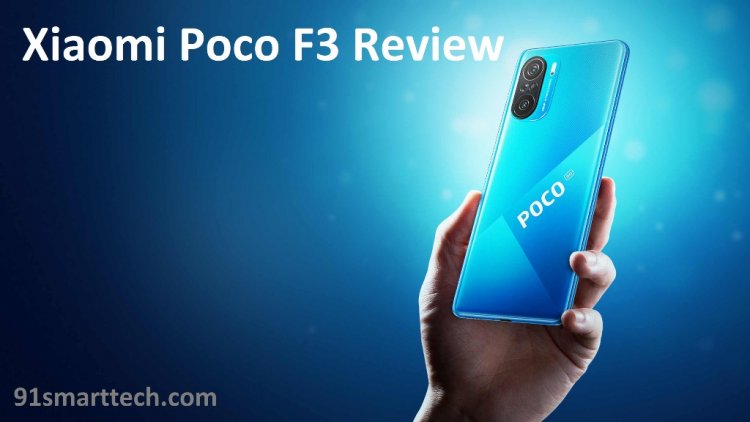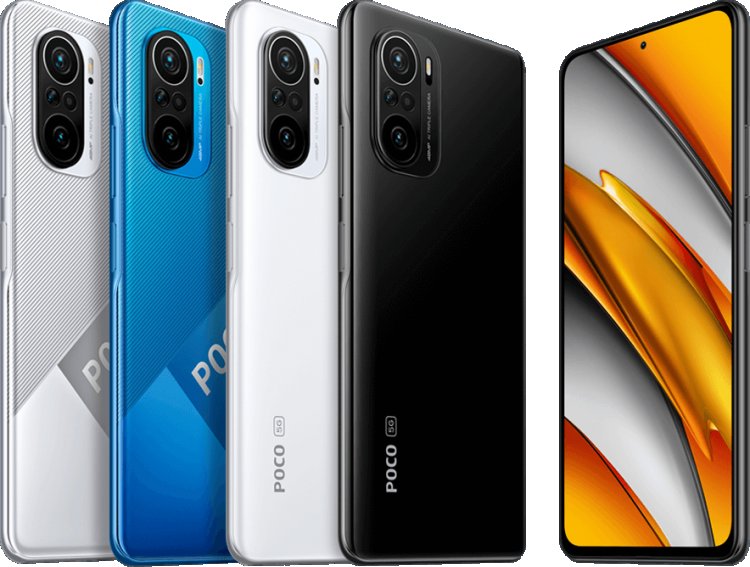Xiaomi Poco F3 Review: After Using Some time My Opinion and Details
Xiaomi Poco F3 Review, Let's take a look at the Poco F3 specifications, features, and other information that is currently available.

REASONS TO BUY
+ Amazing value
+ Excellent display
+ Powerful performance
+ Classy design
REASONS TO AVOID
- Some bloatware
- No water resistance promises
- Network uncertainty
POCO F3 - KEY SPECS
Main screen: FHD+ (2,400 x 1,080) 6.67-inch AMOLED, 120Hz
CPU: Qualcomm Snapdragon 870 5G
GPU: Adreno 650
RAM: 6/8GB
Storage: 64/128GB UFS 3.1
Battery: 4,520mAh
Rear camera: 48MP main, 8MP ultra-wide, 5MP macro
Front camera: 20MP
OS: Android 11 (MIUI skin)
When you look at the spec sheet, Xiaomi's Poco brand has kept releasing inexpensive smartphones that seem to perform significantly better than their price range. Although the company's recently released Poco M4 Pro 5G demonstrated how much it could fit into a device that costs around $280/£210, the Poco F3 only costs a little bit more while serving as a genuine highlight of premium features in a cost-effective phone.
When it comes to providing a slight premium without compromising on price, the Poco F3 almost never overlooks any aspect of the phone. Let's examine the Poco F3's capabilities in more detail.
POCO F3 REVIEW: RELEASE DATE, PRICE
The Poco F3 was initially priced at £329 (roughly $445/AU$599), but it has since dropped to £289 ($390/AU$526). A silicone case, a USB-C cable, a USB-C-to-3.5mm headphone adapter, and a 33W charging brick for EU plugs are included with the phone.
Poco F3 at a starting price in India of Rs 24,990.
POCO F3 REVIEW: DESIGN AND SCREEN
Also Read: Samsung Galaxy S22 Plus Review

The design of the Poco F3 is excellent. Despite its low price, the phone has a sturdy metal frame and Gorilla Glass 5 on the back and front. The model I tried on had a pearly white back that was both bold and subtle in its styling. It is also available in silver, black, and blue. Although the white could have done a better job of concealing fingerprints, I've seen worse from more expensive phones.
That metal frame also houses some cool technology. The USB-C port on the bottom supports fast charging at up to 33W, but I couldn't test this with the included charger due to the incorrect plug type for our region. The phone includes stereo speakers (though the bottom speaker is providing most of the sound).
The phone has a side-mounted fingerprint scanner that also serves as the sleep/wake button, and it works flawlessly. Xiaomi's software for extensively customizing the phone's behavior also makes it simple to get things working the way we want them to.
There's even an infrared emitter built into the phone's top edge, allowing it to double as a remote control for TVs and other appliances, though it can be hit or miss. The phone's dual-SIM tray is located at the bottom and appears to be protected by a rubber gasket. Though there is no IP rating certifying the phone against dust and water ingress, the presence of a gasket suggests there may be some protection.
Also Read: OnePlus Nord 2T Review
Given the phone's low price, the display is the most surprising inclusion. This is the kind of display that most low-cost phones can only dream of having. While many devices choose large displays at the expense of resolution or panel quality, the Poco F3 makes few display sacrifices.
The 6.67-inch screen has a 2,400 x 1,080 resolution, which is more than adequate for most use cases. Even better, that's an AMOLED display with excellent visuals. Colors are well saturated even from different viewing angles (until glare from fingerprints appears), and the screen is plenty bright with a peak brightness of 1300 nits — useful for supporting HDR10+ content. Of course, it has the inky blacks that OLED technology provides.
Just those aspects of the display would be enough to get excited about for a phone at this price. However, Xiaomi has gone above and beyond with the Poco F3, including a 120Hz refresh rate for extra smooth visuals and a 360Hz touch sampling rate to make it even more responsive. Because of this display, using the phone is a breeze, and watching content on it is a true pleasure. I enjoyed the first couple of episodes of The Witcher's latest season, and the atmosphere of that fantastical world was well represented on the screen.
When viewing a lot of content, the display's 20:9 aspect ratio helps keep the punch-hole selfie camera out of the way. Along with the selfie camera, the Poco F3 has slim bezels all around, making it feel very modern. This screen alone is sufficient to justify the higher price over the Poco M4 Pro 5G, but it is far from the only reason.
All of this fit into a relatively small phone. It's only 7.8mm thick and weighs 196 grams, making it more than 20% lighter than an iPhone 13 Pro Max while providing a nearly identical screen. Even the rear camera bump is still relatively shallow.
POCO F3 REVIEW: HARDWARE AND PERFORMANCE

Also Read: Best Laptops Under £500: Best Budget Laptops Under £500...
Given its price, the Poco F3 has surprising hardware. You might expect a Qualcomm Snapdragon 480 or, if you're lucky, a Snapdragon 765G at this price, but the Poco F3 comes with a much more powerful Snapdragon 870. That's not the Snapdragon 888 that powers many of 2021's flagships, but it's plenty powerful for most of the things we do with our phones on a daily basis.
In my Geekbench 5 tests, the Snapdragon 870 chipset achieves a single-core score of 976 and a multi-core score of 3305, outperforming the Snapdragon 765G found in phones such as the Motorola Razr 5G and OnePlus Nord. It also nearly doubles the CPU performance of the Poco M4 Pro 5G, which is powered by a Mediatek Dimensity 810 processor. When it comes to graphics performance, the Poco F3 outperforms the M4 Pro 5G by more than a factor of two, scoring 3,560 in OpenCL and 3,370 in Vulkan.
While benchmarks aren't always an accurate predictor of real-world performance, I can state unequivocally that they are in this case. The Poco F3 performs admirably for an Android phone of any price, but it excels for the money.
Browsing, app switching, and app navigation all work flawlessly. The model I tested has 8GB of RAM, while the base model has 6GB. In my experience, even 6GB of RAM is frequently sufficient, though it may not keep as many apps or large games ready in the background if you frequently switch between apps. Even at High Quality, the phone runs Asphalt 9 flawlessly, though it can stutter at the start of the race as everything loads in — a common issue.
I was able to switch away from the game after a race and still return to it while it was still running in memory. Even from scratch, the phone launches the large game quickly, completing the loading screen in about 10 seconds.
The phone provides adequate connectivity for the modern era. It has a Wi-Fi 6 connection that I was able to see reach over 300Mbps on a 5GHz Wi-Fi 6 connection, though that still fell short of the 600+Mbps connection achieved by the Samsung Galaxy S20 on the same network just seconds before the Poco F3's test.
The phone also supports 5G networking, which I was able to connect to in Chicago using a T-Mobile SIM. However, because 5G network performance varies widely, we didn't see incredible speeds, barely exceeding 10Mbps in the same setting where a Galaxy S20 could extract 200Mbps.
POCO F3 REVIEW: CAMERA, OS AND BATTERY

Also Read: Samsung Galaxy S22 Plus vs Xiaomi 12 Pro vs OnePlus 10...
The camera is probably where the Poco F3 struggles the most to keep up with the flagship phones it's competing with. But it's not bad. The phone has a 48MP main camera with a relatively wide f/1.79 aperture that uses pixel binning to reduce to 12MP and effectively achieve a 1.6-micron pixel size. All of this should help it capture more light for shooting in low-light situations. While the camera performs admirably in low-light situations and does a decent job in darker environments if the subject is adequately lit, the main camera isn't suitable for night photography in the least. In a dark environment, noise and motion blur quickly overpower the redeeming qualities of a picture.
The 8MP ultra-wide camera doesn't quite match the quality of the main sensor, but it's a lot better than the ultra-wide we often see on less expensive phones. When the lighting isn't ideal, it produces a reasonably sharp image that's well-colored and not overly noisy. Distortion is kept to a minimum as well. The ultra-wide lens does have a slightly warmer color temperature than the main camera, so consistency between shots can be an issue.
The Poco F3 also includes a 5MP macro camera, which isn't a throwaway feature. While the uses for a macro lens are limited, this extra camera is useful for capturing fine textures and close-up details that we can't see with our own eyes, such as the fabric of our clothing or the suede and stitching in our shoes. However, getting the focus on exactly what we want can be difficult because the depth of field is extremely shallow and small hand movements can dramatically shift it. Meanwhile, the 20MP selfie camera produces sharp and natural images that do the job well.
Also Read: Best Gaming Phones 2022: Best Gaming Phone in The World
POCO F3 REVIEW: VERDICT


 Mike2051
Mike2051 








